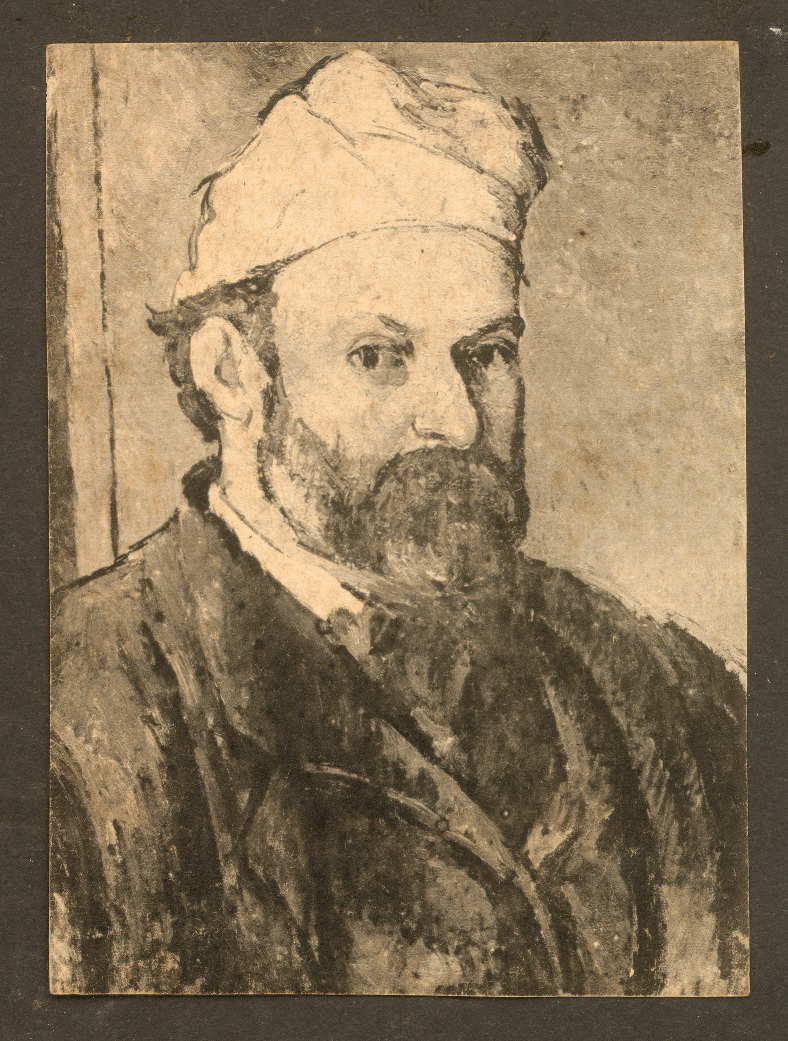自畫像(二)
為提供使用者有文書軟體選擇的權利,本文件為ODF開放文件格式,建議您安裝免費開源軟體 ([連結])
.jpg)
自畫像(二)
Self Portrait (2)
自画像(2)
1930, 畫布油彩, 41×31.5cm
oil on canvas
画布油彩
畫裡的陳澄波煥發著自信,夏日的扶桑花也在他身後綻放出燦爛的色彩。關於自己,這位35歲的畫家在油彩的世界裡,發現了一種理想的表達方式。
Chen Cheng-po beams with self-confidence; behind him, Chinese hibiscus flowers bloom in brilliant summer colors. Within the world of oil painting, the 35-year-old artist had found an ideal mode of self-expression.
この絵の中の陳澄波は自信に満ちています。夏に咲くブッソウゲも背後で鮮やかな色彩を放っています。自己表現について、35歳になった陳澄波は油彩画の世界のなかに一種の理想的な方法を見い出したのです。
從日本來到上海,陳澄波的藝術生涯進入了另一個階段。在那裡,他吸收了中國傳統繪畫的概念與技法,並且找到了與以往不同的風景題材。這幅自畫像,或許也表現了他對未來的信心與期盼。
When Chen moved from Japan to Shanghai, his artistic career entered a new stage. In Shanghai, he found new subject matter for landscape paintings and absorbed the fundamental concepts and techniques of traditional Chinese painting. The confidence and anticipation he then felt for the future is perhaps visible in this self-portrait.
日本から上海へ渡った陳澄波は、その芸術人生において新たな段階へと歩を進めました。上海で中国の伝統絵画の概念や技法を吸収する一方で、それまでとは異なる題材(風景)を見つけたのです。この自画像は自分の将来に対する確信や期待をも表現しているのかもしれません。
 Self Portrait (2).jpg)
1.自畫像
Self-portrait
自画像
自畫像是西洋繪畫裡的重要傳統,畫家通常透過這樣的作品,表現自我個性與生命情志。19世紀末,曾赴歐洲留學的日本西畫家在東京美術學校帶起了自畫像的製作風氣,從該校畢業的的臺灣畫家也多半留下了一些自畫像作品。
Self-portraits constitute an important tradition in Western art and are often used to communicate an artist’s personality and outlook on life. By the end of the 19th century, Japanese artists who had studied in Europe and specialized in Western-style painting brought this tradition to the Tokyo Fine Arts School, setting off a self-portrait trend. As a result, most of the school’s Taiwanese graduates left behind such works.
自画像は西洋画では大切な伝統の一つです。一般に画家はこのような作品を通して、画家自身の個性や生きる姿勢を表現します。19世紀末、東京美術学校ではヨーロッパへ留学した洋画家たちにより、自画像制作の気運が高まりました。同校を卒業した台湾出身の画家たちの多くも自画像を残しています。
2.眼神
The look in his eyes
まなざし
相較於1928年完成的另一幅自畫像,這件作品裡的陳澄波表情顯得較為爽朗,眼神也變得澄澈明亮,這或許是因為在上海時期,他找到了全新的藝術思考與發展路向。畫中的陳澄波斜睨著右側,那沉著的目光,究竟在凝視什麼呢?
While in Shanghai, Chen had discovered a completely new way of contemplating art and a new artistic path to pursue. This perhaps explains why his expression in this work appears much more affable and relaxed than in his 1928 self-portrait; his gaze is also much clearer and more luminous. As he looks calmly to his right, the viewer can’t help but wonder what has captured his attention.
1927年に完成したもう1点の自画像に比べると、この作品の陳澄波の表情はより朗らかで、まなざしも明るく澄んだものへと変化しています。これは上海滞在期間中に、芸術において新たな着想や方向性を見い出したからかもしれません。右方向を睨んでいる陳澄波は、落ち着き払ったまなざしで何を見つめているのでしょうか。
.jpg)
1928年的自畫像裡,陳澄波的神情明顯較為陰鬱,整幅畫的色彩表現也相對暗沉。
自畫像(一),1928,畫布油彩,41×31.5cm。
In his 1928 self-portrait, Chen’s demeanor is visibly despondent; the color palate of the painting also feels relatively dark and melancholic.
Self Portrait (1), 1928, oil on canvas, 41 x 31.5 cm
1928年の自画像に描かれた陳澄波は陰鬱な表情を浮かべており、色彩も全体に暗く沈んだ表現となっている。
自画像(1),1928,画布油彩
3.大衣與毛帽
Coat and woolen hat
オーバーコートと毛糸の帽子
白色毛領的大衣與深色的毛織帽,說明了這幅畫應當完成於上海的冬日時節。在1931年陳澄波與家人合影的一張照片當中,也可以看到他們穿著厚重的衣物,大部分人還戴上了保暖的毛線帽,或許也就是畫裡所描繪的那種帽子吧。
Chen’s winter coat, trimmed with a white fur-lined collar, and his dark woolen hat suggest that this painting was completed during a cold Shanghai winter. In a 1931 photo, Chen and his family are seen dressed in thick winter clothes with warm woolen hats similar to the one worn by Chen in his 1930 self-portrait.
白い毛皮の衿付きのオーバーコートに濃い色のニット帽という装いから、上海滞在中の冬に描かれた絵だとわかります。1931年に撮影された、陳澄波と家族の写真でも厚手のコートを着て、みな暖かそうな毛糸の帽子をかぶっています。この自画像に描かれているのもこのような帽子なのかもしれません。

4.扶桑花
Chinese hibiscus blossoms
ブッソウゲ
儘管穿著厚重的冬衣,陳澄波卻刻意在背景當中,添上了南國色彩的扶桑花,除了配合畫像裡的神采奕奕,或許也是在說明自己的出身與來歷。現存的兩幅自畫像,陳澄波都在背景裡添加了富有熱帶意象的圖案,相當令人玩味。
Although Chen appears dressed for winter, the Chinese hibiscus flowers in the background give the painting a southern touch. The colorful blossoms allude to the artist’s southern roots and enhance the painting’s overall feeling of vitality. In both surviving self-portraits, Chen embellished the background with patterns rich in tropical imagery, offering the viewer an intriguing detail to ponder.
冬物の厚手のオーバーを身にまといながら、陳澄波は意図的に南国の風情漂うブッソウゲの花を背景に描き入れています。溌剌とした感のある自画像に合わせたか、自身の出身や来歴を伝えようとしたのかもしれません。現存する自画像2点はいずれも背景に熱帯をイメージさせる図案が描き込まれてあり、味わい深いものがあります。
5.明信片收藏
Postcard collection
絵葉書のコレクション
梵谷、塞尚等後期印象派名家,對陳澄波的繪畫風格頗有影響,自畫像的製作,或許也參考了這兩位畫家的作法。在陳澄波收藏的美術圖片當中,就有一張塞尚的自畫像,仔細觀察他的神態,是不是與陳澄波的作品頗為相似呢?
Within Chen’s painting style, a strong Post-Impressionist influence can be felt. He probably even studied the self-portraits of Vincent van Gogh and Paul Cézanne when creating his own. Indeed, an image of one of Cézanne’s self-portraits was found among Chen’s collection of postcards. Can’t you see a striking similarity, especially in the expression, between Cézanne’s self-portrait and Chen’s?
ゴッホやセザンヌなどの後期印象派を代表する画家は、陳澄波の画風に大きな影響を与えました。自画像も、この二人を参考にしたかもしれません。陳澄波が収蔵していた絵葉書の中にセザンヌの自画像が1枚ありました。その表情をよく見ると、陳澄波の作品によく似ていると思われませんか。

白色頭巾的自畫像
Self-portrait with White Turban
白い被り物をかぶった自画像
中央研究院臺灣史研究所檔案館授權。
6.厚唇
Thick lips
分厚い唇
陳澄波注意到自己豐厚而紅潤的嘴唇,並在這幅畫裡以鮮明的顏色描繪出這樣的特徵。他的畫家朋友廖繼春,也曾在一幅自畫像裡刻意強調自己的朱紅色厚唇。也許,這兩位前輩畫家都曾經對著鏡子,仔細端詳著自己的嘴唇吧!
Taking note of his plump, rosy-red lips, Chen portrayed this distinctive feature with bright, eye-catching hues. In a self-portrait a few years earlier, fellow painter and friend Liao Chi-chun had deliberately accentuated the fullness of his own scarlet lips. Perhaps when these two pioneers of Taiwanese art studied their reflections, it was to their lips that they paid the most attention!
自身の赤みがかった分厚い唇に気づいた陳澄波は、この自画像で鮮明な色をもってその特徴を描き出しています。陳澄波の友人であり、画家でもある寥継春が描いた自画像も自分の赤く厚みのある唇を意図的に強調しています。この二人の画家たちは鏡に向かいながら、自分の唇をじっくりと観察したのかもしれません。
 Oil on Wood 1926_1926 (2).jpg)
廖繼春,《自畫像》,1926,木板油彩,32x24cm
Liao Chi-chun, Self-portrait, 1926, oil on wood, 32 x 24 cm
寥継春,『自画像』,1926,木板 油彩,32x24cm
廖繼春家屬授權。
